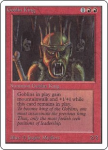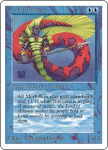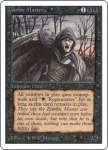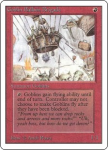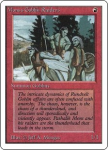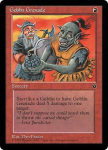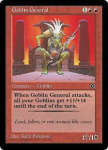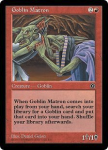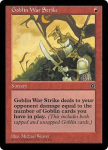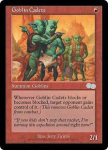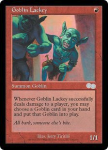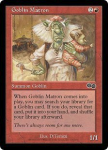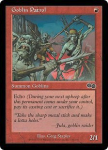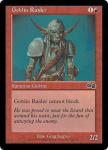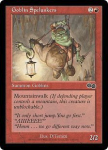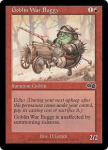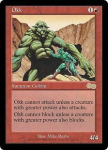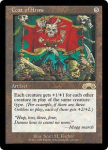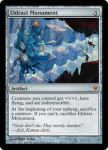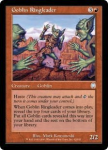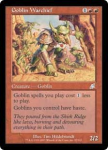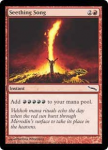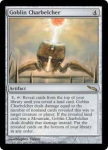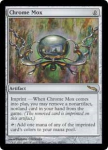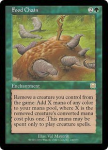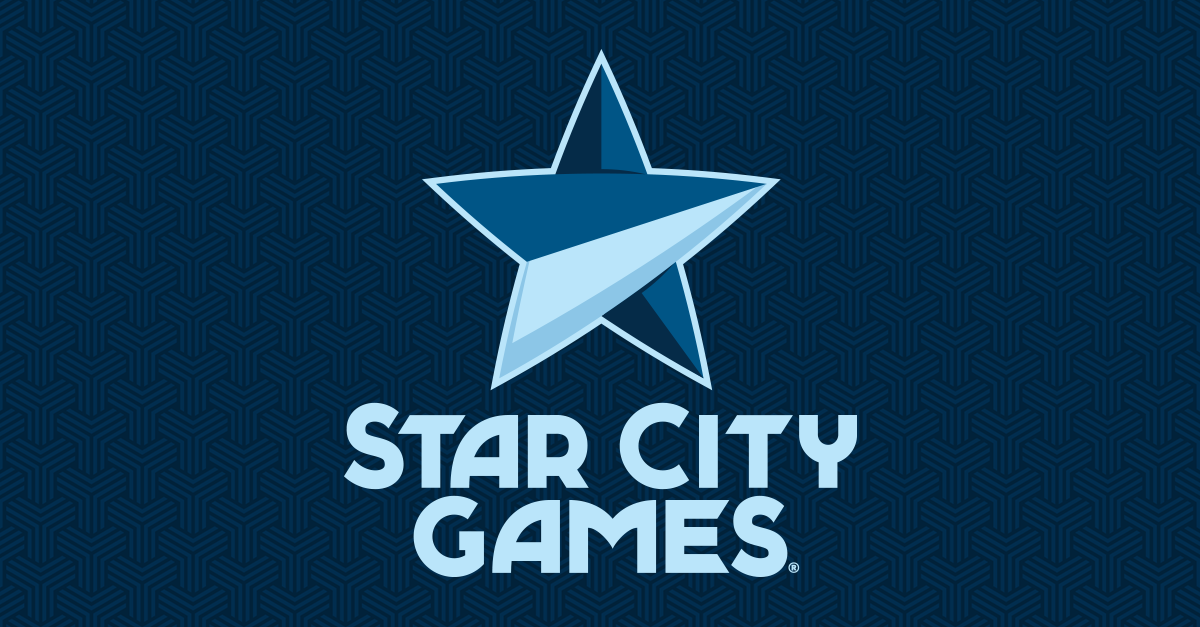Among the highlights of my "second chapter" scenario here is this awkward little goblin.
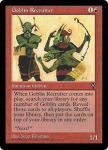
At the time
Visions was released in 1997, and even as new goblins came out with sets like
Tempest, there just weren't a lot of reasons to run Goblin Recruiter, because there wasn't a lot that it could do. Of course, Goblin Recruiter would go on to earn a ban in the Extended format as well as in Legacy, but that would take a while. Back in the 90's, it was an interesting card, but a frustrating one, as it simply didn't seem to have a niche. And that leaves me wondering what the goal actually was. When WotC designed Goblin Recruiter, how did they view it? Even though the card existed in 1997 and I saw it while combing my own collection to build Goblin decks, I cannot recall an instance of anyone saying
anything about Goblin Recruiter prior to the advent of Goblin Ringleader in 2001. I have no memories of it being considered a good card. I have no memories of it being considered a bad card. Goblin Recruiter, in my hazy recollection, simply wasn't talked about.
On the one hand, four years isn't really that long, and it's not as though I thought to seek out commentary on this card back then. I could easily have simply failed to notice the contexts in which Goblin Recruiter was brought up, either because someone used it successfully or was assessing the card as unplayable. Also, this was all so long ago that the internet isn't very helpful. Sites where the topic might have come up are generally dead by now, and commentary on the card exploded once it became a competitive powerhouse in the Extended format. So I don't remember anything and it also shouldn't be surprising that it would be hard to find anything anyway.
On the other hand, it's difficult to even imagine
how I might go about using Goblin Recruiter effectively before 2001, even given the opportunity to try. What goblins would you even stack on top? Goblin King was, at this point, technically not a goblin, so you couldn't build a stack with it. Was there a sensible pile to set up with Goblin Recruiter? If so, what cards would be used alongside it? I'm stumped.
The earliest serious use for Goblin Recruiter that I'm aware of was in 2002, in a deck built by Mons Johnson himself.
4 Goblin Lackey
4 Mogg Fanatic
2 Grim Lavamancer
1 Mogg Raider
4 Goblin Piledriver
2 Mogg Flunkies
4 Goblin Recruiter
1 Sparksmith
1 Goblin Sharpshooter
3 Goblin Ringleader
4 Seal of Fire
2 Goblin Bombardment
4 Terminate
6 Mountain
2 Swamp
4 Sulfurous Spring
4 Bloodstained Mire
1 Shadowblood Ridge
4 Wasteland
3 Rishadan Port
That list is pretty clever, especially because it pioneered the Recruiter + Ringleader engine. Goblin Lackey was already a well-established staple for Goblin decks, and we'll come back to that one. But yeah, this list is not very strong by today's standards. It's a start, but the whole reason that Goblin Recruiter works here is because of the trio of Goblin Ringleaders.
Of course, there is a website with a message board from 1999 that is still around today, and where discussions were focused on casual play, ranging outside the norms of what was viable in established tournament formats. That's right. Goblin Recruiter was mentioned prior to 2001 right here at the CPA. I knew I could count on you guys!

Up first, there's
this thread from March of 2000. It concerns a long-forgotten format that was strikingly similar to the "Tribal Lowlander" concept we'd play some 13 years later. Gizmo ended up playing spikes as his tribe and won the whole event. A user named "Spart" brainstormed a couple of deck ideas for the format, and one of them caused the thread to come up in my search...
Spart said:
But, since I'm a combo player myself, I feel it's my solemn duty to suggest a combo deck as well. Hmmm.... a combo deck based on creature damage.... got it!
Fire Mogg:
4 x mogg maniac
4 x raging goblin
4 x mogg fanatic
4 x goblin recruiter
4 x squee, goblin nabob
1 x will-o-the-wisp
1 x hypnotic specter
1 x masticore
1 x fire covenant
1 x treacherous link
1 x shock
1 x seal of fire
1 x lightning bolt
1 x vampiric tutor
1 x terror
1 x hatred
1 x dark ritual
1 x gamble
1 x demonic consultation
1 x duress
1 x kaervek's purge
1 x badlands
1 x cinder marsh
1 x city of brass
11 x mountain
10 x swamp
This deck can go the hatred route, or the combo with mogg maniac or treacherous link and fire covenant. The consultation is risky and may have to be replaced, I'm considering a plaguelord which would work nicely with all the little goblins, especially the nabob.
All these years later, even at a glace, I can spot some improvements I'd make if I were to actually attempt this concept in this format I just now rediscovered. So the deck has some problems. However, it takes an approach I hadn't thought of, and Goblin Recruiter does make a certain amount of sense here. If you can set up a hand with some cards that present a kill alongside Mogg Maniac, then you might as well stack your deck with Mogg Maniac on top.
And then there's
Whimsical's casual Goblin deck. Sageridder suggested Goblin Recruiter in September of 2000.
sageridder said:
have you tried goblin recruiter ?coat of arms might help survive longer.
Whimsical said:
Thanks for reminding me about that card, mister sagerider sir! It's been nagging me since this morning ...
Exactly HOW does the goblin recruiter work? It says on the card to look for a goblin card in your deck and put on top of your library... clarify for moi. Does it allow for retrieval of Goblin Grenade, Bomb, Bombardment, Caves, Shrine, King, etc., etc., ad nauseaum ... since all those have the word goblin on them ... or is just a cheap way to pull out your maniacs for you to draw next turn?
Gizmo said:
Recruiter only lets you get something with Creature Type: Goblin, unfortunately.
sageridder said:
The recruiter allows you to "stack"your deck.

You may only search for cards that goblin is the creature type on.
Purple_Jester said:
Anyway, to stick with the topic at hand, Goblin Recruiter searchers for the card type "goblin". Therefore, you check the middle left side of a card, just underneath the picture to see if it says "goblin". If it doesn't, then the recruiter can't stack it.
If this were L5R, then any card with "goblin" in the card type or card name would be a legal target. Too bad it isn't. Come to think of it, there SHOULD be a Goblin Recruiter in that game...
Some fun nostalgia in that thread, but Goblin Recruiter wasn't really going anywhere in that deck, so while the discussion is a cute read, it's moot for my purposes. We're reminded me that Coat of Arms used to be $7 back then, which seems like a lot, but I guess it had not yet been reprinted. And I am compelled to pedantically note that Purple_Jester was incorrect about Anvil of Bogardan in this thread: the card no longer hosed Necropotence.
Finally, here's a
weird thread from November of 2000. I mean, the title says that the deck is weird, but I reading through it, I think it's the thread that's weird. Aku Necromancer posted a casual red list.
Aku Necromancer said:
The concept of the deck, is to quickly get out a few mana producers into play. Tangle Wire should buy you enough time for you to do this. Next is to take out there resources via Stone Rain, Seismic Mage, or even the Grenadiers. The kill comes from getting a Moggcatcher out and each turn fetching the marshalls, and not paying the echoe so you get a small force of tokens. With your red horde, and a timely Trumpet Blast you should put some type of beatdown on your opponent. Goblin Grenade to finish him off. Although it is STRICTLY for casual play, Im just wondering how to make it better, and if it would work.
The idea is wacky enough to pique my interest, but the list itself seems to indicate a lack of experience. Hey, if my own decks from 2000 were posted here, they'd look even worse by comparison. But yeah, the original list doesn't seem viable except in the slowest, clunkiest environments. Anyway, the thread showed up in my search because of Galtwish's tangent.
galtwish said:
Goblin Bombardment is the way to go:
4 Goblin Lackey
4 Mogg Fanatic
4 Mogg Maniac
4 Shrieking Mogg
4 Goblin Recruiter
4 Mogg Catcher
4 Goblin Marshall
4 Goblin Bombardment
3 Puppet Strings
2 Fool's Tome
4 Wasteland
1 Shivan Gorge
1 Rath's Edge
1 Keldon Necropolis
18 Mountian
Quickly empty your hand, get a few quick beats in, and then Recruit or Catch your way to victory. Fool's Tome is good for this deck, and Puppet Strings can protect you or allow you to double Catch a turn for 8 mana. Very cool idea Mikeymike, I hope this version at least gives some food for thought.
I have to say, I'm skeptical of this one. Both the original list and Galtwish's version are based on squeezing value out of Moggcatcher. Searching your library will shuffle away Goblin Recruiter's stack, so why use Goblin Recruiter in the first place? Seems like a nonbo. At least the thread is awkwardly funny.
Teferi said:
i meant right there what i said was spam! SORRY AKU SORRY SPIDEY! i in no way meant to say that your post wre spam! i meant what i was saying was spam! I"M SOO SORRY GUYS! BTW spiderman i'll watch my foul mouth, sorry. Man i feel terrible, i'm really really sorry you interpeted it that way. man i feel horrilbe i'll edit that right now.
Duel said:
Eh, I prefer Wakefield's deck:
4 Goblin lackeys
4 Goblin Marshalls
4 Goblin Lackeys
4 Goblin marshalls
2 Goblin lackeys
2 Goblin marshalls
4 trumpet blasts
4 Relentless assault
4 trumpet blasts
4 relentless assaults
24 land
Um, Duel? I don't think that deck is legal anywhere. You've got, count 'em, 10 copies of Goblin Lackey. You can't just hide them by putting them on different lines!
